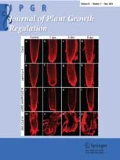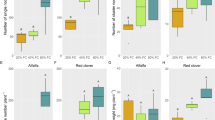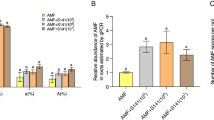Abstract
Production of Jatropha curcas as a biodiesel feedstock on marginal lands is growing rapidly. Biomass production on these lands is limited. Hence, the objective of this study was to evaluate the effect of arbuscular mycorrhiza (AM) fungi and salinity (0.1, 0.2, 0.3, 0.4, and 0.5% NaCl) on (1) seedling growth, leaf relative water content (RWC), lipid peroxidation, solute accumulation (proline and sugars), and photosynthetic pigments (Chl a and b) of Jatropha; (2) mycorrhizal colonization (%) and mycorrhizal dependency (MD) of Jatropha; and (3) glomalin content (Bradford reactive soil protein) in soil. Increased soil salinity significantly (P < 0.05) decreased AM root colonization (r 2 = 0.98) of AM-inoculated plants and decreased survival (r 2 = 0.93) and growth (shoot length, r 2 = 0.89; tap root length, r 2 = 0.93; shoot diameter, r 2 = 0.99; shoot dry weight, r 2 = 0.92; and root dry weight, r 2 = 0.92) of non-AM-inoculated Jatropha. Under salt stress, AM-inoculated Jatropha plants had greater dry weight of shoots and roots, better leaf water status, less leaf membrane damage (low lipid peroxidation activity), higher solute (proline and sugars), and higher leaf chlorophyll concentrations than non-AM-inoculated plants. The mycorrhizal dependency (MD) of Jatropha increased from 12.13 to 20.84% with salinity (0–0.4% NaCl). Root AM colonization (%) and glomalin content in soil were negatively correlated with salinity (P < 0.05, r = −0.95). We conclude that inoculation with AM fungi lessens the deleterious effect of salt stress on seedling growth parameters under salt levels up to 0.5% NaCl (electrical conductivity of 7.2 dS m−1). Inoculation of Jatropha seedlings with AM fungi can promote the establishment of Jatropha under NaCl-induced stress.




Similar content being viewed by others
References
Abbott L, Robson A (1991) Factors influencing the occurrence of vesicular arbuscular mycorrhizas. Agric Ecosyst Environ 35:121–150
Adiku G, Renger M, Wessolek G, Facklam M, Hech-Bischoltz C (2001) Simulation of dry matter production and seed yield of common beans under varying soil water and salinity conditions. Agr Water Manag 47:55–68
Al-Karaki GN (2006) Nursery inoculation of tomato with arbuscular mycorrhizal fungi and subsequent performance under irrigation with saline water. Sci Hortic 109:1–7
Al-Karaki GN, Hammad R, Rusan M (2001) Response of two tomato cultivars differing in salt tolerance to inoculation with mycorrhizal fungi under salt stress. Mycorrhiza 11:43–47
Asghari H, Marschner P, Smith S, Smith F (2005) Growth response of Atriplex nummularia to inoculation with arbuscular mycorrhizal fungi at different salinity levels. Plant Soil 273:245–256
Ashraf M, Foolad MR (2007) Roles of glycine betaine and proline in improving plant abiotic stress resistance. Environ Exp Bot 59:206–216
Augé RM, Brown MS, Bethlenfalvay GJ, Stodola AJW (1992) Stomatal response of mycorrhizal cowpea and soybean to short-term osmotic stress. New Phytol 120:117–125
Augé RM, Schekel KA, Wample RL (1987) Rose leaf elasticity changes in response to mycorrhizal colonization and drought acclimation. Physiol Plant 70:175–182
Bates LS, Waldren RP, Teare ID (1973) Rapid determination of free proline for water-stress studies. Plant Soil 39:205–207
Berta G, Fusconi A, Trotta A, Scannerini S (1990) Morphogenetic modifications induced by mycorrhizal fungus Glomus strain E3 in the root system of Allium porrum L. New Phytol 114:207–215
Cantrell IC, Linderman RG (2001) Preinoculation of lettuce and onion with VA mycorrhizal fungi reduces deleterious effects of soil salinity. Plant Soil 233:269–281
Colla G, Rouphael Y, Cardarelli M, Tullio M, Rivera CM, Rea E (2008) Alleviation of salt stress by arbuscular mycorrhizal in zucchini plants grown at low and high phosphorus concentration. Biol Fertil Soils 44:501–509
Cornillon P, Palloix A (1997) Influence of sodium chloride on the growth and mineral nutrition of pepper cultivars. J Plant Nutr 20:1085–1094
Dixon RK, Garg VK, Rao MV (1993) Inoculation of Leucaena and prosopis seedlings with Glomus and Rhizobium species in saline soil: rhizosphere relations and seedlings growth. Arid Soil Res Rehabil 7:133–144
Feng G, Li XL, Zhang FS, Li SX (2000) Effect of AM fungi on water and nutrition status of corn plants under salt stress. Chin J Appl Ecol 11:595–598
Gara De L (2004) Class III peroxidases and ascorbate metabolism in plants. Phytochem Rev 3:195–205
Giri B, Mukerji KG (1999) Improved growth and productivity of Sesbania grandiflora Pers. under salinity stress through mycorrhizal technology. J Phytol Res 12:35–38
Giri B, Mukerji K (2004) Mycorrhizal inoculant alleviates salt stress in Sesbania aegyptiaca and Sesbania grandiflora under field conditions: evidence for reduced sodium and improved magnesium uptake. Mycorrhiza 14:307–312
Giri B, Kapoor R, Mukherji KG (2002) VA Mycorrhizal techniques/VAM technology in establishment of plants under salinity stress conditions. In: Mukherji KG, Manoharachari C, Singh J (eds) Techniques in mycorrhizal studies. Kluwer Academic Publishers, Dordrecht, pp 313–327
Giri B, Kapoor R, Mukherji KG (2003) Influence of arbuscular mycorrhizal fungi and salinity on growth, biomass, and mineral nutrition of Acacia auriculiformis. Biol Fertil Soils 38:170–175
Giri B, Kapoor R, Mukerji KG (2007) Improved tolerance of Acacia nilotica to salt stress by arbuscular mycorrhiza, Glomus fasciculatum may be partly related to elevated K/Na ratios in root and shoot tissues. Microb Ecol 54:753–760
Hanway JJ, Heidel H (1952) Soil analysis methods as used in Iowa State college soil testing laboratory. Iowa Agric 57:1–31
Hartmond U, Schaesberg NV, Graham JH, Syverten JP (1987) Salinity and flooding stress effects on mycorrhizal and nonmycorrhizal citrus rootstock seedlings. Plant Soil 104:37–43
He Z, He C, Zhang Z, Zou Z, Wang H (2007) Changes of antioxidative enzymes and cell membrane osmosis in tomato colonized by arbuscular mycorrhizae under NaCl stress. Colloids Surf B Biointerfaces 59:128–133
Heath RL, Packer L (1968) Photoperoxidation in isolated chloroplasts. I. Kinetics and stoichiometry of fatty acid peroxidation. Arch Biochem Biophys 125:189–198
Jacoby B (1994) Mechanism involved in salt tolerance by plants. In: Pessarakli M (ed) Handbook of plant and crop stress. Marcel Dekker, NewYork, pp 97–145
Jahromi F, Aroca R, Porcel R, Ruiz-Lozano JM (2008) Influence of salinity on the in vitro development of Glomus intraradices and on the in vivo physiological and molecular responses of mycorrhizal lettuce plants. Microb Ecol 55:45–53
Johnson-Green P, Kenkel NC, Booth T (1995) The distribution and phenology of arbuscular mycorrhizae along an inland salinity gradient. Can J Bot 73(9):1318–1327. doi:10.1139/b95-143
Johnson-Green P, Kenkel NC, Booth T (2001) Soil salinity and arbuscular mycorrhizal colonization of Puccinellia nuttalliana. Mycol Res 105:1094–1100
Jones HG, Jones MB (1989) Introduction: some terminology and common mechanisms. In: Jones HG, Flowers TJ, Jones MB (eds) Plant under stress: biochemistry, physiology and ecology and their application to plant improvement. Cambridge University Press, New York, pp 1–10
Juniper S, Abbott LK (2006) Soil salinity delays germination and limits growth of hyphae from propagules of arbuscular mycorrhizal fungi. Mycorrhiza 16:371–379
Kumar A, Sharma S (2008) An evaluation of multipurpose oil seed crop for industrial uses (Jatropha curcas L.): a review. Ind Crops Prod 28:1–10
Kumar A, Sharma S, Mishra S (2009) Effect of alkalinity on growth performance of Jatropha curcas inoculated with PGPR and AM fungi. J Phytol 1(3):177–184
Levy Y, Dodd J, Krikun J (1983) Effect of irrigation, water salinity, and rootstock on the vertical distribution of vesicular–arbuscular mycorrhiza in citrus roots. New Phytol 95(3):397–403. doi:10.1111/j.1469-8137.1983.tb03507.x
Marschner H (1995) Mineral nutrition of higher plants, 2nd edn. Academic, New York
Mayer AM, Poljakoff-Mayber A (1963) The germination of seeds. Pergamon Press, Oxford
McMillen BG, Juniper S, Abbott LK (1998) Inhibition of hyphal growth of a vesicular–arbuscular mycorrhizal fungus in soil containing sodium chloride limits the spread of infection from spores. Soil Biol Biochem 30(13):1639–1646. doi:10.1016/S0038-0717(97)00204-6
Miransari M, Smith DL (2007) Overcoming the stressful effects of salinity and acidity on soybean [Glycine max (L.) Merr.] nodulation and yields using signal molecule genistein under field conditions. J Plant Nutr 30:1967–1992
Miransari M, Bahrami HA, Rejali F, Malakouti MJ, Torabi H (2007) Using arbuscular mycorrhiza to reduce the stressful effects of soil compaction on corn (Zea mays L.) growth. Soil Biol Biochem 39:2014–2026
Miransari M, Bahrami HA, Rejali F, Malakouti MJ (2008) Using arbuscular mycorrhiza to reduce the stressful effects of soil compaction on wheat (Triticum aestivum L.) growth. Soil Biol Biochem 40:1197–1206
Mukerji KG, Chamol BP (2003) Compendium of mycorrhizal research. A. P. H. Publishers, New Delhi, 310 pp
Neocleous D, Vasilakakis M (2007) Effects of NaCl stress on red raspberry (Rubus idaeus L. ‘Autumn Bliss’). Sci Hortic (Amsterdam) 112(3):282–289. doi:10.1016/j.scienta.2006.12.025
Ojala JC, Jarell WN, Menge JA, Johnson ELV (1983) Influence of mycorrhizal fungi on the mineral nutrition and yield of onion in saline soil. Agron J 75:255–259
Olsen SR, Cole CV, Watanabe FS, Dean LA (1954) Estimation of available phosphorus in soils by extraction with sodium bicarbonate. USDA, Circ US Dept Agric No. 939, Washington, DC
Peng Y-L, Gao Z-W, Gao Y, Liu G-F, Sheng L-X, Wang D-L (2008) Eco-physiological characteristics of alfalfa seedlings in response to various mixed salt-alkaline stresses. J Integrative Plant Biol 50(1):29–39
Phillips JM, Hayman DS (1970) Improve procedures for clearing roots and staining parasitic and vesicular–arbuscular mycorrhizal fungi for rapid assessment of infection. Trans Br Mycol Soc 55:158–161
Plenchette C, Fortin JA, Furlan V (1983) Growth response of several plants species to mycorrhiza in soil of moderate P fertility: mycorrhizal dependency under field conditions. Plant Soil 70:191–209
Poss JA, Pond E, Menge JA, Jarrell WM (1985) Effect of salinity on mycorrhizal onion and tomato in soil with and without additional phosphate. Plant Soil 88(3):307–319. doi:10.1007/BF02197488
Porcel R, Ruiz-Lozano JM (2004) Arbuscular mycorrhizal influence on leaf water potential, solute accumulation, and oxidative stress in soybean plants subjected to drought stress. J Exp Bot 55(403):1743–1750. doi:10.1093/jxb/erh188
Rabie GH (2005) Influence of arbuscular mycorrhizal fungi and kinetin on the response of mungbean plants to irrigation with seawater. Mycorrhiza 15:225–230
Rabie GH, Almadini AM (2005) Role of bioinoculants in development of salt-tolerance of Vicia faba plants. Afr J Biotechnol 4:210–222
Ramoliya P, Patel H, Pandey AN (2004) Effect of salinization of soil on growth and macro- and micro-nutrient accumulation in seedlings of Salvadora persica (Salvadoraceae). For Ecol Manage 197:181–193
Rillig MC (2004) Arbuscular mycorrhizae, glomalin and soil quality. Can J Soil Sci 84:355–363
Rillig MC, Wright SF, Eviner VT (2002) The role of arbuscular mycorrhizal fungi and glomalin in soil aggregation: comparing effects of five plant species. Plant Soil 238:325–333
Ruiz-Lozano JM (2003) Arbuscular mycorrhizal symbiosis and alleviation of osmotic stress. New perspectives for molecular studies. Mycorrhiza 13:307–317
Ruiz-Lozano JM, Azcón R (1995) Hyphal contribution to water uptake in mycorrhizal plants as affected by the fungal species and water status. Physiol Plant 95:472–478
Sannazzaro AI, Ruiz OA, Albertó EO, Menéndez AB (2006) Alleviation of salt stress in Lotus glaber by Glomus intraradices. Plant Soil 285:279–287
Schenck NC, Perez Y (1990) Manual for the identification of VA mycorrhizal fungi. Synergistic Publications, Gainesville, FL, 286 pp
Schellenbaum L, Berta G, Ravolanirina F, Tisserant B, Gianinazzi S, Fitter AH (1991) Influence of endomycorrhizal infection on root morphology in a micropropagated woody plant species (Vitis vinifera L.). Ann Bot 68(2):135–141
Schonfeld MA, Johnson RC, Carver BF, Mornhinweg DW (1988) Water relations in winter wheat as drought resistance indicator. Crop Sci 28:526–531
Sharma MP, Gour A, Bhatia NP, Adholeya A (1996) Growth responses and dependence of Acacia nilotica var. cupriciformis on the indigenous arbuscular mycorrhizal consortium of a marginal wasteland soil. Mycorrhiza 6:169–177
Sheng M, Tang M, Chen H, Yang B, Zhang F, Huang Y (2008) Influence of arbuscular mycorrhizae on photosynthesis and water status of maize plants under salt stress. Mycorrhiza 18:287–296
Smith S, Read D (1997) Mycorrhizal symbiosis. Academic Press, London, pp 453–469
Strain HH, Svec WA (1966) Extraction, separation, estimation and isolation of chlorophylls. In: Vernon LP, Seely GR (eds) The chlorophylls. Academic Press, New York, pp 21–66
Thimmaiah SR (2004) Standard methods of biochemical analysis. Kalyani Publishers, New Delhi, 545 pp
Tian CY, Feng G, Li XL, Zhang FS (2004) Different effects of arbuscular mycorrhizal fungal isolates from saline or non-saline soil on salinity tolerance of plants. Appl Soil Ecol 26:43–48
Trappe JM (1982) Synoptic keys to the genera and species of zygomycetous mycorrhizal fungi. Phytopathology 72:1102–1108
Wang GB, Cao FL (2004) Effects of soil salt and water contents on growth and biomass allocation of Taxodium distichum. Chin J Appl Ecol 15(12):2396–2400
Wang W, Vinocur B, Altman A (2003) Plant responses to drought, salinity and extreme temperatures: toward genetic engineering for stress tolerance. Planta 218:1–14
Wright SF, Upadhyaya A (1998) A survey of soils for aggregate stability and glomalin, a glycoproteins produced by hyphae of arbuscular mycorrhizal fungi. Plant Soil 198:97–107
Wright SF, Upadhyaya A, Buyer JS (1998) Comparison of N linked oligosaccharides of glomalin from arbuscular mycorrhizal fungi and soils by capillary electrophoresis. Soil Biol Biochem 30:1853–1857
Wu QS, Xia RX, Zou YN (2006) Reactive oxygen metabolism in mycorrhizal and non-mycorrhizal citrus (Poncirus trifoliata) seedlings subjected to water stress. J Plant Physiol 163:1101–1110
Yang CW, Xu HH, Wang LL, Liu J, Shi DC, Wang GD (2009) Comparative effects of salt-stress and alkali-stress on the growth, photosynthesis, solute accumulation, and ion balance of barley plants. Photosynthetica 47(1):79–86
Zandavalli RB, Dillenburg LR, de Souza PVD (2004) Growth responses of Araucaria angustifolia (Araucariaceae) to inoculation with the mycorrhizal fungus Glomus clarum. Appl Soil Ecol 25:245–255
Zhu YG, Miller RM (2003) Carbon cycling by arbuscular mycorrhizal fungi in soil-plant systems. Trends Plant Sci 8:407–409
Zuccarini P, Okurowska P (2008) Effects of mycorrhizal colonization and fertilization on growth and photosynthesis of sweet basil under salt stress. J Plant Nutr 31(3):497–513. doi:10.1080/01904160801895027
Acknowledgments
The authors thank the Council of Scientific and Industrial Research, New Delhi, India, for providing financial support.
Author information
Authors and Affiliations
Corresponding author
Rights and permissions
About this article
Cite this article
Kumar, A., Sharma, S. & Mishra, S. Influence of Arbuscular Mycorrhizal (AM) Fungi and Salinity on Seedling Growth, Solute Accumulation, and Mycorrhizal Dependency of Jatropha curcas L.. J Plant Growth Regul 29, 297–306 (2010). https://doi.org/10.1007/s00344-009-9136-1
Received:
Accepted:
Published:
Issue Date:
DOI: https://doi.org/10.1007/s00344-009-9136-1




